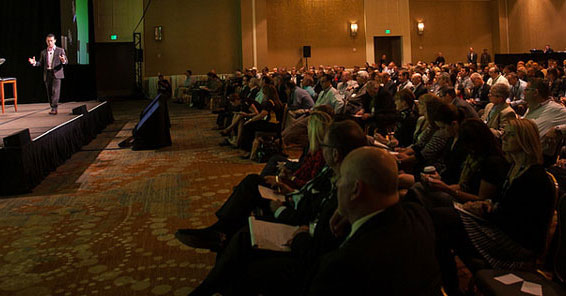Call to Action: Turn Marketing Spend into Successful Franchisee Recruitment

It’s a new year and a new era of franchisee recruitment. Franchisors are ready to return to the business of growth, and they’re finding motivated and informed buyers.
“The volume on the lead generation side is exploding,” says R. Scott Sutton, chief development officer of Empower Brands. “Across all channels, we are seeing that lead generation will continue to be a competitive and difficult row to hoe as we get into a very active calendar year of 2025. Add a high volume of interest and an increased amount of tactical execution among competitors and other franchisors, and you’ve got high competition.”
It’s no secret that recruiting the right franchisees is critical to the success of any franchise system. It can truly make or break it. But in today’s competitive landscape, where capturing attention has become a commodity, how do you ensure lead generation efforts draw in candidates who truly share your brand’s vision and values?
To stand out, franchisors are taking a modern, data-driven approach. This includes identifying their ideal franchise partners, tracking detailed engagement metrics, and using those insights to adjust and refine strategies in real time while staying within budget.
The focus has shifted from a sales-centric development model to prioritizing quality over quantity. Empower Brands has adopted a franchisee selection process that puts the candidate first. Sutton says this nuanced candidate-driven strategy resonates with prospects eager to become part of Empower Brands’ family of 10 commercial and residential service brands.
“I think there is a tendency for franchisors to talk too much about themselves,” Sutton says. “There’s a place for that, but we’ve really led with, ‘How you can achieve your goals and aspirations in partnership with Empower and let us talk to you about how.’ I think candidates really want to understand and be seen and heard for what they’re trying to achieve.”
Modern approach
At its core, franchisee recruitment’s end goal remains: identify, attract, and convert qualified prospects into high-caliber franchise partners. Today’s development process, however, is no longer about casting the widest net. It requires a combination of targeting specific buyer personas on multiple channels, hyper-personalized targeting, compelling messaging, and consistent follow-up to attract and retain attention and earn the candidate’s trust.
“Our approach is to attract people like a magnet,” says Dustin Thompson, director of franchise development and marketing for Jack in the Box, with roughly 2,200 locations, and Del Taco, home to 600 restaurants.
When Thompson joined Jack in the Box in 2021 to help the mission to reignite nationwide franchise growth, there was a website but little else to support the effort.
Thompson has played a pivotal role in transforming development efforts and the look and feel of franchise opportunities with Jack in the Box and Del Taco. Key initiatives included revamping and optimizing the recruitment website and mapping out a data-driven plan for market expansion to guide digital and traditional marketing and advertising. Recruitment strategies, except for public relations, are handled in-house.
Transparency is at the heart of the dual brand’s franchise development approach supported by a vertically integrated content, marketing, and franchisee sales tech stack that automates, supports, and tracks all things franchise recruitment.
Taking a page from Marcus Sheridan’s popular book, Thompson focuses recruitment efforts on building a better buyer experience through an easily accessible and digestible hub-and-spoke lead-nurturing content strategy that helps would-be franchisees self-qualify.
“The key is content, and our goal, whether it is a social post, blog, or video, is to answer questions so that people can determine whether we’re a good fit for them or not before they ever have to inquire,” Thompson says.
Creating a lead generation team within the franchise development department has been a win-win for the franchisor, saving money and making it easy to develop high-quality, brand-authentic content that generates strong leads.
The creation of seamless, tech-forward lead generation processes has resulted in a halo effect for Jack in the Box and Del Taco, legacy brands with more than 120 years between them. The approach shines a modern and innovative light that aligns with the expectations of today’s franchisees, says Van Ingram, vice president of franchise development for both brands.
Without any budget increases in the past three years, both brands have experienced a steady influx of leads and prospects ready to become franchisees.
“We’re creating more qualified candidates, people who understand what they’re getting into and are advanced already,” Ingram says. “By the time they show up and we put them in front of our qualified operations staff, they are ‘approvable.’”
Multi-brand efforts
Multi-brand franchisors are finding success and maximizing budgets with strategies that harness the power of the franchise network and highlight each brand’s value proposition.
Empower Brands’ franchise recruitment arsenal includes standard digital marketing tactics, like paid search, paid social, optimization, retargeting, online engagement (particularly on LinkedIn), and loads of a/b testing. Sutton also looks to outbound and offline tactics, such as public relations and event-based marketing, including E-Day, a monthly gathering at Empower Brands’ corporate office in Richmond, Virginia, that gives prospective owners an inside look at operations.
With a vibrant system of brands, ranging from 40-year-old industry leader Archadeck Outdoor Living to Bumble Roofing, founded in 2019, Empower aims to reach and match highly qualified candidates with the right franchise fit within the overall portfolio based on the model, market, and motivation to become a franchisee in the system.
“We are seeing today, without fail, a more educated candidate than we’ve ever seen—bar none,” Sutton says. “And when I say educated, it might be about our model, it might be about the market, it might just be about franchising, or all of those. But I will tell you that people are more educated today, in my opinion, than they’ve ever been.”
While Sutton is spending more money to reach those discerning prospects than in the past, he knows his data. He uses it to calculate ROI, hedge his bets, and watch his budget when driving decisions and staying innovative. Metrics, like lead volume, close rate, and cost per lead, guide every move. Channel investments are based on prior performance and a tolerance to experiment with a new tactic to see if it delivers and converts in a meaningful way.
“We do fail fast,” Sutton says. “Things that aren’t working, we’re pivoting those dollars into other channels.”
Unleashed Brands’ marketing strategy works on two levels. Each brand—Urban Air Adventure Park, The Little Gym, Sylvan Learning, Snapology, XP League, Class 101, Premier Martial Arts, and Water Wings Swim School—receives a customized marketing plan tailored to its unique growth goals, development stage, and target audience. Platform-wide initiatives, such as shared campaigns and cross-promotional efforts, create synergy across the entire portfolio, explains Abby Fogel, vice president of brand management and communications for Unleashed Brands. System-wide, the company awarded more than 200 new franchises and opened 116 new locations in 2024.
“This dual-layered approach optimizes growth for individual brands while leveraging the collective power of the platform,” Fogel says.
ROI
Unleashed Brands starts every franchise development marketing budget by reverse engineering the process to meet growth goals. Factors that influence budget decisions include:
- The number of new franchisees projected for each brand
- The historical cost per deal, factoring in potential market changes or variations in lead quality
The total marketing budget is calculated by multiplying the target number of franchisees by the cost per deal. From there, it’s all about strategic allocation, Fogel says.
“We divide the budget across key channels: digital ads, content creation—like fresh videos and storytelling—PR, and more, balancing lead generation with building long-term brand awareness,” Fogel says. “A portion is also reserved for testing new strategies or making website enhancements. This ensures we’re staying innovative and adaptable in a fast-changing market.”
Staying agile is key, which means keeping up with industry and tech trends. These days, headlines are dominated by artificial intelligence (AI).
Unleashed has turned to AI as the initial touchpoint for leads, handling outreach and scheduling introductory calls with recruiters. The move has reduced the time it takes to go from an inquiry to a scheduled call and increased the number of calls booked. Unleashed Brands is reaching more qualified prospects faster than before using AI.
“By automating those early interactions, we free up our team to focus on building deeper, more meaningful relationships further down the funnel,” Fogel adds. “AI helps us be efficient without sacrificing the personal touch that’s so important in franchise development. We have crafted compelling content that we constantly refine to maximize our efforts.”
Thompson is also intrigued by leveraging AI to pull data and provide immediate insights.
“It can provide real-time reporting on trends you may or may not have felt but couldn’t put your finger on,” Thompson says. “It can quickly find commonalities between lead conversions, which can help you make data-informed decisions much quicker.”
Advancements in video also provide a competitive edge. Feature-rich, tailored video allows Thompson and his team at Jack in the Box and Del Taco to easily produce messaging for outreach or follow-up via a cell phone or computer. It’s a more personal approach than email.
“It’s not uncommon for our sales team to record five-plus videos per day,” Thompson says. “We do this to stand out from our competition, but most importantly, we do this because it allows us to connect with people remotely in a more personable way. This entire business is built on relationships, and that starts from the first time they interact with our franchise website.”
Josh York, founder and CEO of GymGuyz, was an early adopter of innovative strategies to promote brand awareness. The brand practices a hybrid franchise development model using brokers and organic, omnipresent marketing. York, who launched his brand from a dining room table in 2008, is a pro at sharing the story of GymGuyz. He relies largely on digital methods, and his “Fuel Your Drive” podcast generates an estimated 60,000 to 70,000 downloads per episode.
“If someone’s not talking about you, then you’re not making enough noise,” York says.
The world’s largest in-home and on-site personal training company, with 180 locations in 27 states and three countries, remains in growth mode, projecting to open 85 to 100 locations in 2025.
“We award franchises; we don’t sell them,” York says. “I make sure I’m very disciplined when it comes to trying to bring in the right people.”
Overcoming hurdles
The opportunities in franchise recruitment aren’t without challenges. They include managing rising costs while adapting to new automated tools and other budget constraints and capturing the attention of buyers in an increasingly crowded digital space.
“You can have the best content available, but if it doesn’t capture a candidate’s attention within a few seconds, the ability to convert that lead drops drastically,” Thompson says. “As consumers ourselves, we know all of our candidates are receiving marketing and advertising messages 24/7 across their desktops and, predominantly, mobile devices. The amount of time we have to grab their attention with a digital ad or social post is extremely short.”
No matter the approach for lead generation and recruitment, each provides franchisors valuable lessons for strategically allocating resources to maximize marketing and advertising budgets as long as it’s being tracked.
Measuring clear KPIs, such as engagement rates, click-through rates, conversion rates, and the amount of time audiences spend on content, remains critical to measuring and refining the effectiveness of every step of the development process.
Still, there’s no guarantee the prospect you sign will be the franchise owner that recruiters first envisioned. York emphasizes the importance of defining and understanding your ideal franchisee profile.
“It’s really understanding your avatar of who is going to be successful,” York says. “But that’s always going to be a challenge. You have to do a good job and make sure you have the infrastructure and operations internally to support that person and make sure you are driving them and holding them accountable.”
Ultimately, brands with a high-value proposition, strong unit-level economics, and happy franchisees have a story to tell. At Empower Brands, referrals from existing franchise owners remain the top tactic for conversions as the platform seeks to grow and scale the culture of its system.
“I think you can create an emotional call to action by putting the candidate as the hero in the story, not the brand,” Sutton says. “If you’re adopting the science and you can blend in the art, then you’ve got something that’s special, and fundamentally, you’ve got a good brand.”
Getting Results with Best Practices
The franchise development team at Del Taco and Jack in the Box exemplify best practices in targeting high-quality prospects while maximizing the impact of their marketing and advertising budgets. The moves to overhaul the franchise development process for both brands, which lean heavily on transparency and in-house video content creation with a personal touch, are paying off.
Without increasing the budget from 2022 to 2024, the multi-brand franchisor achieved significant improvements across all stages of the recruitment process, including a 71% reduction in cost per deal, a 68% decrease in cost per qualified lead, a 245% increase in total leads, a 209% growth in qualified leads, a 154% rise in sales-qualified leads, and a 164% surge in meetings booked.
Dustin Thompson, who serves as director of franchise development and marketing for both brands, shared how the brands are achieving lead generation success and lessons other brands can adopt.
Define goals annually
Effective franchise recruitment begins with clearly defined objectives. The team sets annual targets for marketing qualified leads (MQLs), sales qualified leads (SQLs), and target markets to ensure everyone on the development team is on the same page with the goals of both brands.
Leverage data
Data analytics drives every step of the recruitment process.
“Once we’ve defined our target audiences and are aligned on what qualifies as a qualified lead, we take a running average of our historical conversions from each funnel step from prior years to make a data-informed decision on what metrics are most closely related to achieving our lead goals for the year,” Thompson explains.
The lead generation team monitors each step of the lead generation and sales process. The more than 30 KPIs tracked include website conversion rates, video views, minutes of videos watched, email engagement metrics, the speed of lead follow-ups, and the cost per lead, MQL, SQL, and closed deals.
These goals and insights are analyzed daily, weekly, monthly, quarterly, and yearly via a robust sales and marketing tech stack that provides a comprehensive window into what works and what doesn’t, so adjustments can be made.
“This allows us to keep producing the content our candidates need to determine if our brands are a good fit for them as quickly as possible,” Thompson adds.
If Thompson’s CMS/CRM doesn’t provide what he needs, he seeks tools that support the development effort. For instance, integrating the video marketing platform Wistia has provided a seamless way to deliver data directly into a candidate’s profile and identify the content that resonates the most so that the team can refine its approach.
The right message
Understanding the target audience is important when driving direction. With data on ideal candidates and target groups in hand, Thompson and his team shift their focus to where they are looking to expand the presence of Jack in the Box and Del Taco.
“Where do those people live? Where can we target those people?” Thompson says. “Then we work on setting up marketing, digital marketing, and partnerships with magazines and publications to go out and find those groups. The second part is identifying and sharing that information with those potential prospects on our website.”
Creating personas and segmenting potential candidates informs digital strategies, content strategies, and offline methods, such as trade shows, to connect in person, Thompson says.
For example, if targeting a prospect in the hotel industry, the messaging might focus on how QSR franchising differs from hotel franchising, define available territories, and/or explain site requirements. Extensive website content is easy for prospects to find and digest.
“The key is conversations,” Thompson says. “We want to generate really beneficial conversations with qualified leads, and this allows us to get in front of those leads faster because we’re providing more information to them sooner.”
Advice for Recruiting Franchisees from the Pros
- “Stay flexible and open to change—that’s my biggest piece of advice. The franchise world is always evolving, and the strategies that worked last year may not resonate with today’s candidates. Take time to review and adapt your processes regularly to keep up with the market and your audience’s needs. Most importantly, remember that technology is just a tool. At the heart of every successful franchise system are strong relationships, whether it’s with franchisees, customers, or your internal team. Stay focused on building trust, creating value, and fostering a culture that people want to be part of. That’s what will set you apart in the long run.”—Abby Fogel, vice president of brand management and communications, Unleashed Brands
- “Most brands do not have lead generation teams within their franchise development departments, and I think this is a huge miss. We were able to bring these roles in-house, which saved a great deal of money on agency fees. Beyond that, it provided us the ability to produce better content more quickly. Because our content is produced in-house, the content we write, produce, and record is done so by those who are living the brand each day. This leads to better quality content, which leads to better quality leads.”—Dustin Thompson, director of franchise development and marketing, Jack in the Box and Del Taco
- “I would encourage anyone in the franchise marketplace looking at their ad budget to be prepared to make incremental spend. But you’ve got to know your data. You have to know where your dollars are performing, where you’re getting ROI, and where you’re not. If you’re not doing that, then you can spend more, but you’re at risk for not delivering anything above what you’re delivering today.”—R. Scott Sutton, chief development officer, Empower Brands
- “With the continuation of the world toward convenience and how people have everything within seconds on their phone, you have to continue to be very aggressive with creating that omnipresence. You can’t do one thing and not do the others. You have to have your hands in a little bit of everything. Test and see what works, and if something doesn’t work, pull away from it and try something else.”—Josh York, founder and CEO, GymGuyz
Share this Feature
Recommended Reading:
| ADVERTISE | SPONSORED CONTENT |
FRANCHISE TOPICS
- Multi-Unit Franchising
- Get Started in Franchising
- Franchise Growth
- Franchise Operations
- Open New Units
- Franchise Leadership
- Franchise Marketing
- Technology
- Franchise Law
- Franchise Awards
- Franchise Rankings
- Franchise Trends
- Franchise Development
- Featured Franchise Stories
FEATURED IN

Franchise Update Magazine: Issue 1, 2025
| ADVERTISE | SPONSORED CONTENT |








 The franchise listed above are not related to or endorsed by Franchise Update or Franchise Update Media Group. We are not engaged in, supporting, or endorsing any specific franchise, business opportunity, company or individual. No statement in this site is to be construed as a recommendation. We encourage prospective franchise buyers to perform extensive due diligence when considering a franchise opportunity.
The franchise listed above are not related to or endorsed by Franchise Update or Franchise Update Media Group. We are not engaged in, supporting, or endorsing any specific franchise, business opportunity, company or individual. No statement in this site is to be construed as a recommendation. We encourage prospective franchise buyers to perform extensive due diligence when considering a franchise opportunity.